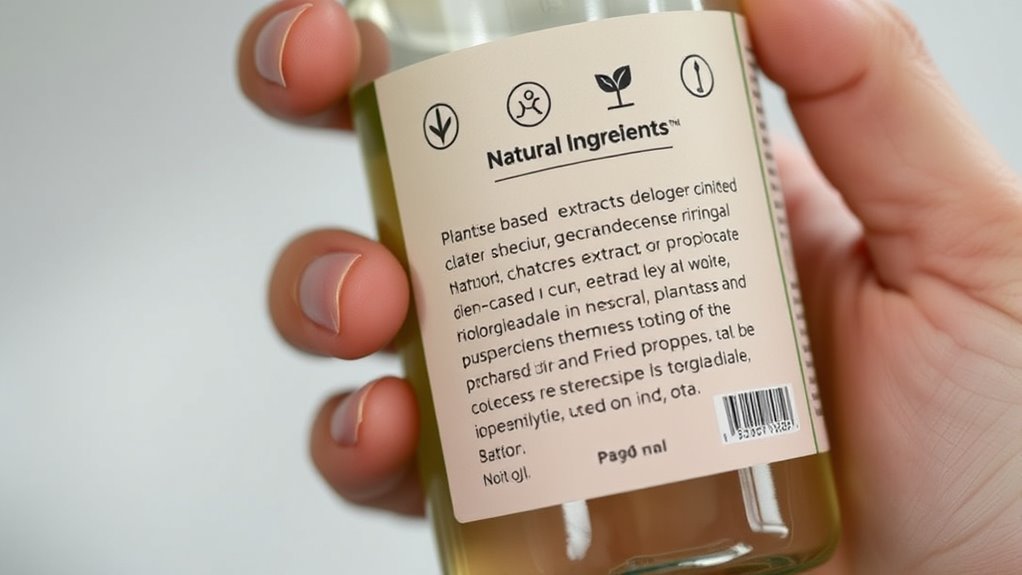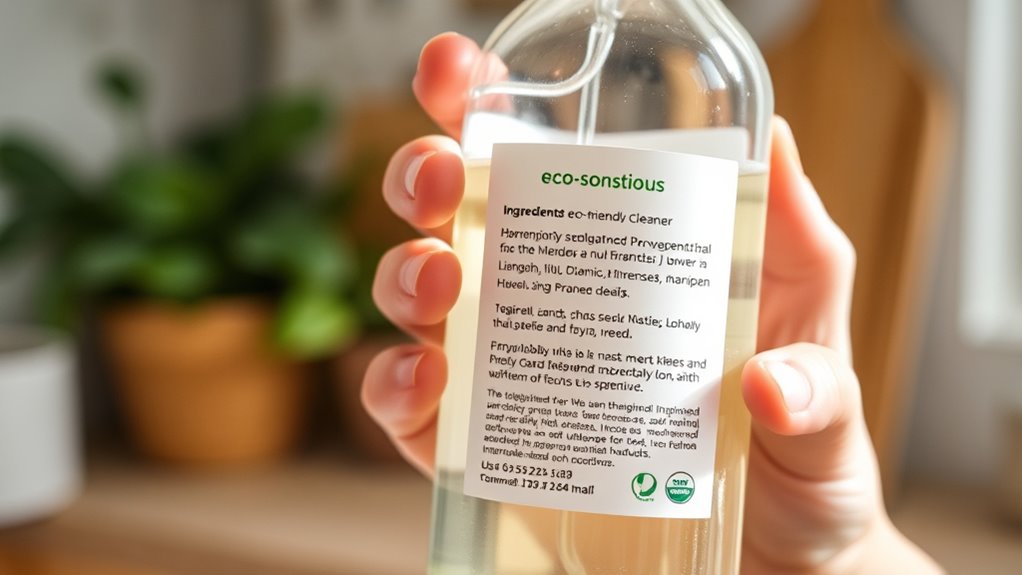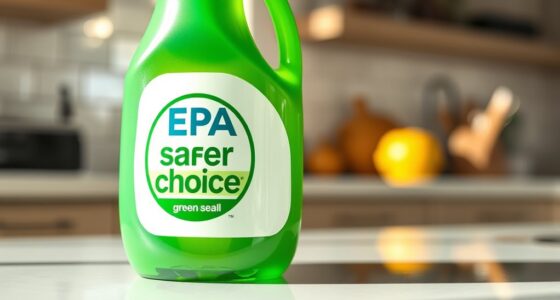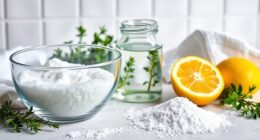When checking ingredient labels on eco-friendly cleaners, focus on clear, readable lists of ingredients and look for natural, plant-based components. Avoid harsh chemicals like chlorine, ammonia, and synthetic fragrances, and seek labels indicating biodegradability and non-toxicity. Verify any unfamiliar ingredients and research their safety and environmental impact. Prioritize brands that are transparent about sourcing and testing. By paying attention to these details, you’ll make informed choices that support your health and the environment—keep going to learn more.
Key Takeaways
- Look for transparent, easy-to-read ingredient lists to understand product contents clearly.
- Check for biodegradable, non-toxic ingredients that are safe for the environment and aquatic life.
- Avoid harsh chemicals like chlorine, ammonia, and synthetic fragrances commonly found in cleaners.
- Seek certifications or eco-labels indicating sustainable sourcing and eco-friendly formulations.
- Research unfamiliar ingredients to ensure they are safe, non-toxic, and environmentally responsible.

When choosing eco-friendly cleaners, reading the ingredient labels is essential to guarantee you’re making safe and sustainable choices. This step helps you understand what’s actually in the product and ensures it aligns with your values and health concerns. Start by looking at the list of ingredients—preferably one that’s transparent and easy to read. Many eco-friendly brands prioritize natural ingredients, but it’s still important to verify that no harmful chemicals are hidden within. Pay close attention to the chemical safety of each component; even some natural-sounding ingredients can cause allergies or skin irritation. Avoid cleaners with harsh chemicals like chlorine, ammonia, or synthetic fragrances, as these can pose health risks for you and your family.
Always read ingredient labels to ensure eco-friendly cleaners are safe, natural, and free from harmful chemicals.
Beyond personal safety, understanding ingredients helps you gauge the environmental impact of a product. Eco-friendly cleaners aim to minimize harm to ecosystems, so check for ingredients that are biodegradable and non-toxic to aquatic life. Look for certifications or labels indicating sustainable sourcing or environmentally friendly formulations. When you read labels carefully, you can identify products that avoid harmful preservatives, artificial dyes, or petrochemicals, which contribute to pollution and long-term environmental damage. Choosing products with plant-based ingredients or those certified by reputable environmental organizations reduces your ecological footprint and supports sustainable practices.
You should also be aware of ingredient concentrations. Some products list ingredients in very small amounts, which might seem safe but could still cause issues if they accumulate or are used frequently. If you notice ingredients you’re unfamiliar with, do a quick online search to understand their safety profile and environmental impact. This proactive approach helps you avoid unknowingly supporting products that might be misleadingly labeled as eco-friendly but contain questionable substances. Remember, the absence of certain chemicals doesn’t automatically make a cleaner safe—it’s the overall formulation and sourcing that matter most.
Lastly, trust your instincts and prioritize brands that are transparent about their ingredient sourcing and testing. Many eco-friendly companies provide detailed ingredient lists and explain their commitment to safety and sustainability on their websites. By taking the time to read and understand labels, you’re not only protecting your health but also contributing to a cleaner planet. Your careful scrutiny ensures you choose products that truly reflect your commitment to chemical safety and reducing environmental impact, making your cleaning routine more responsible and effective.
Frequently Asked Questions
Are Natural Ingredients Always Safer Than Synthetic Ones?
Natural ingredients aren’t always safer than synthetic ones, despite common natural myths. You should know that synthetic ingredients can be safe and effective, while some natural ones may cause allergies or irritation. It’s important to look beyond labels and understand the synthetic truths and natural myths. Always research ingredients, consider your skin sensitivities, and choose products based on safety data rather than assumptions about natural equals safer.
How Can I Identify Harmful Chemicals Not Listed on Labels?
You can identify harmful chemicals not listed on labels by researching brands’ transparency policies and seeking third-party testing results. Be cautious of hidden chemicals and undisclosed additives often hidden under vague terms like “fragrance” or “special ingredients.” Contact manufacturers directly for detailed ingredient info, and use apps or databases that flag harmful substances in cleaning products. Staying informed helps you avoid potential risks from unlisted toxic chemicals.
Do Eco-Friendly Labels Guarantee the Product Is Truly Safe?
Eco-friendly labels are like a clear window, but sometimes, natural misconceptions and label loopholes hide the full view. They don’t always guarantee safety, as ingredients might be understated or misrepresented. You need to look beyond the label, researching brands and ingredients independently. Trustworthy brands often go the extra mile to be transparent. So, don’t assume a label alone guarantees a product’s safety—do your homework to make truly eco-conscious choices.
Can I Trust Third-Party Certifications on Eco-Cleaners?
You can generally trust third-party certifications on eco-cleaners because they adhere to strict certification standards, ensuring products meet environmental and safety criteria. These organizations evaluate ingredients, manufacturing processes, and packaging. However, always look for transparent brand practices, as some companies may display certifications without full transparency about their ingredients or processes. Combining trusted certifications with brand transparency gives you a clearer picture of a product’s eco-friendliness and safety.
What Should I Do if I Have an Allergic Reaction?
Ever wondered what to do during an allergic reaction? If you experience one, act quickly by rinsing the affected area with water and taking antihistamines if available. Seek emergency steps like calling 911 or going to the nearest hospital if symptoms worsen or escalate. Don’t ignore allergic reactions—they can be severe. Stay prepared by knowing your allergens and having emergency contacts handy to guarantee your safety and well-being.
Conclusion
By understanding ingredient labels, you take control of what goes into your home, what you use to clean, and what you share with your family. You can compare products confidently, choose safer options, and make eco-friendly choices that matter. You can read labels with clarity, recognize harmful ingredients, and embrace transparency. You can become a mindful consumer, a responsible shopper, and a healthier home occupant. Ultimately, reading labels empowers you to make better, safer, greener decisions every time you clean.








